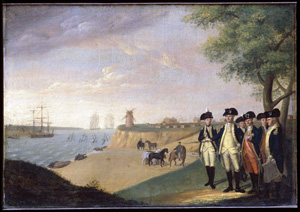The Yorktown Campaign

With British strategy in the Carolinas faring badly after a series of brutal and costly battles, Lieutenant General Charles Cornwallis became convinced that the war needed to be taken to the most important of the rebellious colonies. Therefore, in May 1781 he marched his army north from North Carolina into Virginia, where they narrowly missed capturing Governor Thomas Jefferson and the Virginia assembly in Charlottesville on June 4. Thereafter his troops faced an American force of 3,000 soldiers under the command of the Marquis de la Fayette. Cornwallis and la Fayette's troops engaged in a series of battles at Spencer's Ordinary near Williamsburg on June 26 and on July 6 at Green Spring.
Ordered by Sir Henry Clinton—the British commander-in-chief in America—to establish a naval base on the Chesapeake Bay, Cornwallis settled his 6,000 troops in Yorktown on the York River on August 1. Recognizing the weakness of his position, he immediately began to fortify the area with entrenchments. The American and French commanders, George Washington and the Comte de Rochambeau, recognized Cornwallis's untenable situation and quickly moved to combine their forces in an attack on the town. To deceive the British into thinking that American strategy continued to be focused on New York, the allied leaders split their 7,000 men into three columns for the march to Virginia. It was not until August 30, when the French and American forces were well into New Jersey, that the British realized the shift.
Sailing from the Caribbean with a fleet of 26 ships, the French Admiral, the Comte de Grasse, entered the mouth of the Chesapeake on August 30, effectively cutting off Cornwallis from any source of reinforcements or avenue of escape. De Grasse's arrival brought on a series of naval engagements in early September in the Chesapeake Capes against 19 ships of the line under British Admiral Thomas Graves. Graves was unable to move the French fleet, which closed the water route to Cornwallis just as la Fayette's forces blocked the only land route off of the Peninsula. Cornwallis' plea to Clinton for assistance did not fall on deaf ears: a force of 7,000 British soldiers and 27 warships departed New York for Virginia on October 19. But by then it was too late.
On September 28, Washington and Rochambeau, with a combined force of 16,800 men (including those of la Fayette, Grasse, and the Virginia militia), marched from Williamsburg to Yorktown. Cornwallis gave up his outermost earthworks on September 30. The placement of siege guns, trenches, and breastworks, began on October 6, followed by a regular cannonade of the British positions. On October 14, night assaults captured two redoubts, allowing the allied forces to dig trenches even closer to the town. Under a steady bombardment, Cornwallis attempted to escape across the river to Gloucester on October 16 but was thwarted by a sudden storm. With no escape possible, no relief expected, and mounting casualties, Cornwallis surrendered on October 19.
Learning of the surrender at Yorktown, the British Parliament voted on February 27 to suspend offensive operations in America. The ministry of Lord North fell three weeks later. The new administration, under the earls of Rockingham and Shelburne, commenced informal peace talks in Paris on April 12, 1783. Formal peace negotiations began in September.






















